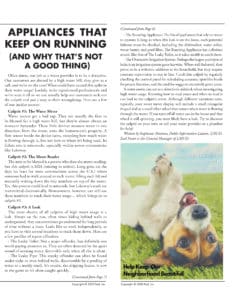Appliances that Keep on Running (And Why That’s Not a Good Thing)

As published in Lake Travis View, August 2020 and Lakeway Voice, Sept. 2020.
Appliances that Keep on Running
(And Why That’s Not a Good Thing)
Often times, our job as a water provider is to be a detective. Our customers are alerted by a high water bill, they give us a call, and we’re on the case! What could have caused this spike in their water usage? Luckily, we’re experienced professionals and we’ve seen it all so we can usually help our customers seek out the culprit and put a stop to their wrongdoing. Here are a few of our insider secrets:
Culprit #1: The Water Meter
Water meters get a bad rap. They are usually the first to be blamed for a high water bill, but they’re almost always an innocent bystander. These little devices measure water in one direction: from the street, onto the homeowner’s property. A flow sensor inside the device turns, recording how much water is flowing through it, but not how or where it’s being used. Its failure rate is minuscule, especially within newer communities like Lakeway.
Culprit #2: The Meter Reader
The next to be blamed is a person who does the meter reading, but this culprit is MIA (missing in action). Long gone are the days (at least for most communities across the U.S.) where someone had to walk around to each meter, lifting each lid and manually writing down the tiny numbers on top of the meter. Yes, this process could lead to misreads, but Lakeway’s reads are transmitted electronically. Homeowners, however, can still use these numbers to track their water usage… which brings us to culprit #3.
Culprit #3: A Leak
The most elusive of all culprits of high water usage is a leak. Always on the run, often times hiding behind walls or underground, they can sometimes go undetected for long periods of time without a trace. Leaks like to work independently, so you have to visit several locations to track them down. Here are a few profiles of repeat offenders:
- The Leaky Toilet: Not a major offender, but definitely one worth paying attention to. They are often detected by the quiet sound of running water, detectable only when all else is silent.
- The Leaky Pipe: This sneaky offender can often be found under sinks or even behind walls, discoverable by a pooling of water or a moldy smell. It’s cousin, the dripping faucet, is new to the game so it’s often caught quickly.
- The Running Appliance: The list of appliances that rely on water to operate is long so when this leak is on the loose, each potential hideout must be checked, including the dishwasher, water softer, water heater, and pool filter. The Running Appliance has a distinct sound, like that of The Leaky Toilet, so it takes stealth to catch them.
- The Overactive Irrigation System: Perhaps the largest purveyor of leaks is an irrigation system gone haywire. When well-behaved, they prove to be a welcome addition to the household, but they require constant supervision to stay in line. Catch this culprit by regularly checking the control panel for scheduling accuracy, sprinkler heads for proper function, and the yard for soggy or excessively green areas.
A water meter can act as a detective’s sidekick when investigating high water usage. Knowing how to read yours and when to read it can lead to the culprit’s arrest. Although different variations exist, typically, your water meter display will include a small triangular shaped dial or a small silver wheel that rotates when water is flowing through the meter. If you turn off all water use in the house and that wheel is still spinning, you most likely have a leak. Try to discover the culprit on your own or call your water provider or a plumber for help!
Written by Stephanie Threinen, Public Information Liaison, LMUD. Earl Foster is the General Manager of LMUD.




 You are now being redirected to the WaterSmart page.
You are now being redirected to the WaterSmart page.